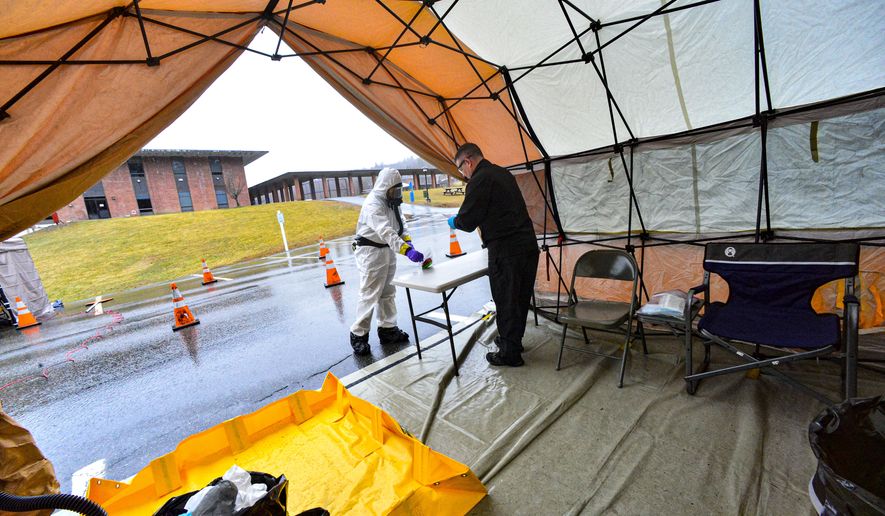The U.S. has conducted nearly 900,000 coronavirus tests across the country after fumbling at the start because of too few tests and faulty kits, the federal government says.
The increased numbers give the White House a chance to shift policy to allow more tests to surveil the population while retaining diagnosis as the No. 1 priority, officials say.
The Federal Emergency Management Agency provided a statement to The Washington Times that said more than 685,000 tests had been completed in state and local public health and commercial laboratories. The White House said 90% of tests are now conducted in private labs.
The 50 states, the District of Columbia, Guam and Puerto Rico have a total of 92 testing sites.
“U.S. Federal officials and the U.S. Public Health Service are working closely with state, local and private sector partners to bolster testing capabilities and supplies,” FEMA said in a written statement. “We’re working to make testing more easily accessible to high risk populations: healthcare facility workers, and first responders.”
President Trump touted the uptick Saturday while sending off the hospital ship USNS Comfort from Norfolk, Virginia, to New York City.
“What we’ve done in building systems, we’re now the No. 1 tester anywhere in the world, by far,” Mr. Trump said. “We’re testing more in one day than other countries are testing in weeks, in months.”
South Korea, at more than 300,000 tests, was the world leader in identifying and containing COVID-19 early on as the virus left the city of Wuhan, China, via thousands of travelers and spread globally. The U.S. recorded its first case Jan. 15 in Washington state in a traveler who had been to Wuhan.
The South Korean government separated citizens who tested positive from their families, but the U.S. chose to encourage the infected to self-isolate at home.
Scientists believed that, like the 2002 severe acute respiratory syndrome (SARS) coronavirus outbreak, COVID-19 came from bats that spread the germs in a wild animal meat market — this time in Wuhan. China said in February that it had shut down such markets across the country.
The Association of Public Health Laboratories said it has faced many challenges to increase testing and still has shortages.
“While the number of both private and public health laboratories capable of testing is expanding, the country is still facing testing challenges including shortages of materials required for testing (such as laboratory supplies, testing reagents and personal protective equipment ),” the association says on its website. “As such, testing needs to be limited to priority groups until sufficient testing supplies become more widely available.”
Dr. Deborah Birx, a career government virus researcher and White House coronavirus adviser, said this weekend was a time to set a strategy to “weave together” more testing to surveil the population with diagnostic testing.
“I think what we’re going to work on over the weekend is to weave together both a testing strategy for surveillance, which you have brought up in that key point, while maintaining a strong testing for diagnosis,” Dr. Birx said. “Our first obligation is still to ensure that patients get diagnosed.”
The increased testing has produced a higher number of confirmed cases, sending the United States, the third most populated country, to the top spot with 124,686 coronavirus cases.
As of Sunday, the U.S. had 2,191 COVID-19 deaths, according to the Johns Hopkins University interactive coronavirus tracker website. Italy leads the world with 10,023 fatalities.
The U.S. death rate of five per 1 million people is below those of most European countries, according to Our World in Data at Oxford University in England. The U.S. and Europe felt the virus invasion in January.
Italy, struck hard by clusters of outbreaks in Lombardy, home to a number of Chinese workers, has a rate of 145 coronavirus deaths per million, compared to 100 in Spain, 32 in the Netherlands, 30 in France, 25 in Belgium, 11 in the United Kingdom and four in Germany.
Dr. Anthony Fauci, like Dr. Birx a key adviser to Mr. Trump, told CNN on Sunday that testing is the key to addressing new urban hot spots in Detroit, New Orleans and elsewhere.
“If we do testing, identification, isolation, getting people out of circulation who are infected and contact tracing, we might be able to prevent those areas from getting to that stage where we’d have to do mitigation, which is much more than difficult and much more frustrating than trying to contain,” said Dr. Fauci, director of the National Institute of Allergy and Infectious Diseases.
• Rowan Scarborough can be reached at rscarborough@washingtontimes.com.




Please read our comment policy before commenting.